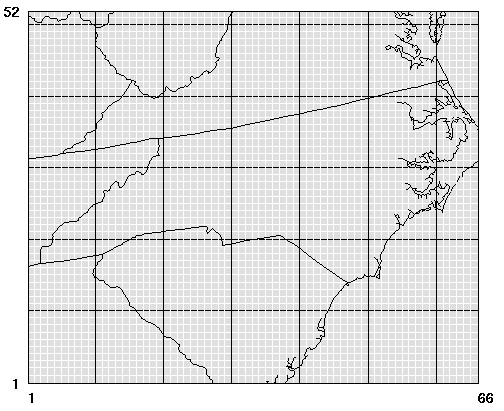Many of the support files used in the test cases are based on the EPA’s NEI modeling platform, available online at EPA’s Emission Modeling Clearinghouse (http://www.epa.gov/ttn/chief/emch/).
The nctox case provides users with an example of using both criteria and toxics emissions inventories. The purposes of this case include:
-
Providing a test case for SMOKE on users computers. It is not recommended for actual user's emissions modeling work.
-
Provide example scripts that users may adapt to their own cases
This case has the following major features. It runs for July 10th and 11th, 2005 on a 12-km Lambert Conformal grid over North Carolina. The spatial extent of this case has been limited to provide a relatively fast test case, and the domain is a subdomain of EPA’s 12-km national grid. The case includes toxics processing for stationary area, nonroad mobile, and point sources.
At this time, the case uses North Carolina records only from the following inventory data:
stationary area sources: 2005 NEI for CO, NOx, VOC, SO2, NH3, PM10, and PM2.5 from nonpt, averfire and alm sectors
nonroad mobile sources: 2005 NEI for CO, NOx, VOC, SO2, NH3, PM10, and PM2.5 from nonroad sector
point sources: 2005 NEI for CO, NOx, VOC, SO2, NH3, PM10, and PM2.5 from ptipm and ptnonipm sectors
mobile sources: Vehicle mileage traveled (VMT) and average sppeed (SPEED) for onroad mobile sources and vehicle population (VPOP) for offroad mobile sources
biogenic sources: BELD3 data processed using BEIS3 (for entire grid, even those cells that are not in North Carolina)
For area, mobile, and point sources, this case uses toxics inventories for ozone modeling. The VOC model species for the current CB5 mechanism are based in part on the toxic inventory. SMOKE resolves the duplicate VOC mass caused by combining VOC emissions with toxic VOC emissions by subtracting the toxic VOC mass from the VOC mass and computing a NONHAPVOC emissions value. This is the “integrate” approach for VOC emissions, described in Section 2.9.5, “Combine toxics and criteria inventories”. The speciation profiles provided with this version of SMOKE include profiles that map the toxics VOC and NONHAPVOC pollutants to current CB5 species. Choices for speciation profiles in this version of SMOKE are listed in Section 4.4.10, “Use a different speciation mechanism or change speciation inputs”.
In addition to the inventory data listed above, the parameters of the case are the following:
-
Episode: July 10th and 11th of 2005
-
Output time zone: Greenwich Mean Time (zone 0)
-
Projection: Lambert Conformal with Alpha=33, Beta=45, Gamma=-97, and center at (-97,40)
-
Domain: Origin at (1128, -672) kilometers with 66 columns by 52 rows and 12-km square grid cells (shown in Figure 4.1, “nctox domain”)
-
Meteorology data: Daily (25-hour) 2005 meteorology files generated originally by EPA using MM5 and MCIP; the files have been reduced to the modeling domain and contain only the variables needed by SMOKE.
-
Chemical speciation data: Revised
GSPROandGSREFfiles to include toxic pollutants mapped to current-CB5 mechanism for both on-road and nonroad mobile source classification category (SCC) codes.
